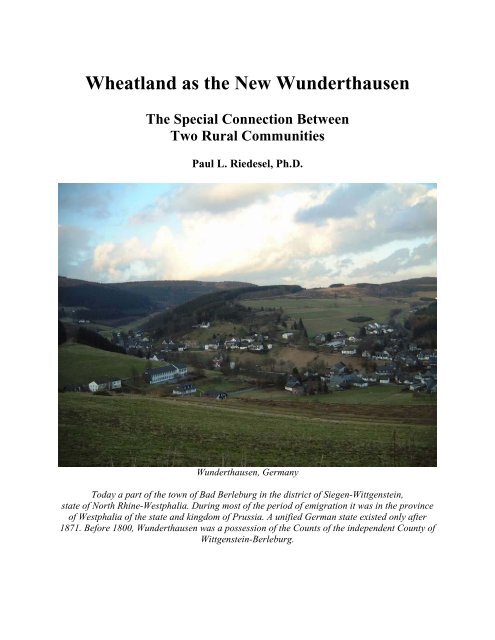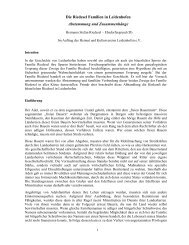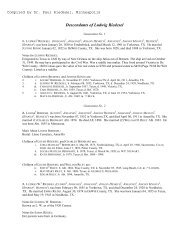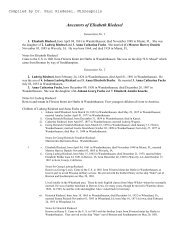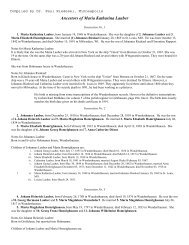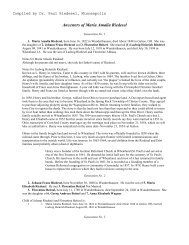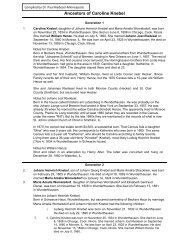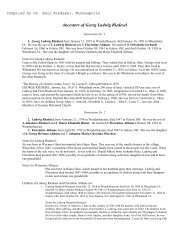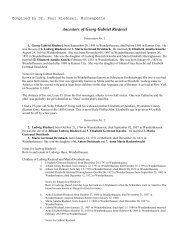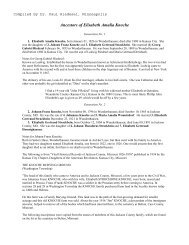Wheatland as the New Wunderthausen - Riedesel.org
Wheatland as the New Wunderthausen - Riedesel.org
Wheatland as the New Wunderthausen - Riedesel.org
You also want an ePaper? Increase the reach of your titles
YUMPU automatically turns print PDFs into web optimized ePapers that Google loves.
<strong>Wheatland</strong> <strong>as</strong> <strong>the</strong> <strong>New</strong> <strong>Wunderthausen</strong><br />
The Special Connection Between<br />
Two Rural Communities<br />
Paul L. <strong>Riedesel</strong>, Ph.D.<br />
<strong>Wunderthausen</strong>, Germany<br />
Today a part of <strong>the</strong> town of Bad Berleburg in <strong>the</strong> district of Siegen-Wittgenstein,<br />
state of North Rhine-Westphalia. During most of <strong>the</strong> period of emigration it w<strong>as</strong> in <strong>the</strong> province<br />
of Westphalia of <strong>the</strong> state and kingdom of Prussia. A unified German state existed only after<br />
1871. Before 1800, <strong>Wunderthausen</strong> w<strong>as</strong> a possession of <strong>the</strong> Counts of <strong>the</strong> independent County of<br />
Wittgenstein-Berleburg.
<strong>Wheatland</strong> <strong>as</strong> <strong>the</strong> <strong>New</strong> <strong>Wunderthausen</strong><br />
No history of <strong>Wheatland</strong> would be complete without a review of <strong>the</strong> extraordinary migration to<br />
this community from one small region of Germany between 1850 and 1880. During this period,<br />
well over 100 souls from <strong>the</strong> village of <strong>Wunderthausen</strong> came to call <strong>Wheatland</strong> home, if only for<br />
a while. 1 They were joined by o<strong>the</strong>rs from <strong>the</strong> neighboring villages of Diedenshausen and<br />
Girkhausen, all in <strong>the</strong> district of Wittgenstein. Most were farmers so were not literally citizens of<br />
<strong>the</strong> town, but <strong>Wheatland</strong> and its German Reformed church were at <strong>the</strong>ir center.<br />
The Wunderthäuser, in <strong>the</strong> German expression, formed <strong>the</strong> majority of <strong>Wheatland</strong>'s large<br />
German community and were <strong>the</strong> dominant force in founding and sustaining St. Paul's church.<br />
E<strong>as</strong>ily a third of <strong>the</strong> gravestones in St. Paul's Cemetery contain names that are still common in<br />
<strong>the</strong> cemetery of <strong>Wunderthausen</strong> today. Personal ties to "<strong>the</strong> old country" have long faded, <strong>as</strong> h<strong>as</strong><br />
<strong>the</strong> once unmistakably German character of St. Paul's church. Never<strong>the</strong>less, <strong>the</strong> story of <strong>the</strong><br />
emigration from one rural village in Germany to ano<strong>the</strong>r on <strong>the</strong> Iowa frontier merits<br />
remembering.<br />
The purpose of this essay is to outline that. This is not <strong>the</strong> place for reporting genealogical<br />
details. 2 Ra<strong>the</strong>r, our focus is on <strong>the</strong> unfolding historical processes that created a unique,<br />
flourishing community around <strong>Wheatland</strong>. If your family tree includes people with names such<br />
<strong>as</strong> <strong>Riedesel</strong>, Homrighausen, Schneider, Strackbein, Knoche or selected o<strong>the</strong>rs from <strong>the</strong><br />
<strong>Wheatland</strong> area, this story is yours.<br />
<strong>Wheatland</strong> in <strong>the</strong> Period of Emigration<br />
Iowa achieved statehood in 1846, though Clinton County had been <strong>org</strong>anized in 1840. What<br />
became <strong>the</strong> Spring Rock Township (including <strong>Wheatland</strong>) in 1852 w<strong>as</strong> originally part of <strong>the</strong><br />
Liberty Township, one of only six <strong>org</strong>anized <strong>as</strong> of 1840. 3 <strong>Wheatland</strong> w<strong>as</strong> incorporated in 1858.<br />
In 1850 Iowa had a total non-Indian population of barely 190,000 people, of whom 2,822 lived<br />
in Clinton County. The 1850 Census tallied 215 residents in <strong>the</strong> Liberty Township, none of<br />
whom reported being born in Germany. As <strong>the</strong> following figures show, <strong>the</strong> area around<br />
<strong>Wheatland</strong> w<strong>as</strong> soon to absorb many German-born emigrants, though <strong>the</strong>y were never <strong>the</strong><br />
majority. 4 Tallies of those of Irish origin are shown for contr<strong>as</strong>t.<br />
1 All references to "<strong>Wheatland</strong>" in this paper implicitly include <strong>the</strong> farms around <strong>the</strong> town itself. Most lay in <strong>the</strong><br />
Spring Rock Township of Clinton County, but <strong>the</strong> larger community extended into <strong>the</strong> Liberty Township of Clinton<br />
County and to adjacent are<strong>as</strong> of Scott and Cedar Counties <strong>as</strong> well.<br />
2 The author, however, h<strong>as</strong> extensive genealogical information on most of <strong>the</strong>se German emigrants and <strong>the</strong>ir<br />
ancestors that he is happy to share.<br />
3 Allen, L. P., History of Clinton County, Iowa, Containing A History of <strong>the</strong> County, its Cities, Towns, Etc. and<br />
Biographical Sketches of Citizens, War Record of its Volunteers in <strong>the</strong> late Rebellion, General and Local Statistics,<br />
Portraits of Early Settlers and Prominent Men, History of <strong>the</strong> Northwest, History of Iowa, Map of Clinton County,<br />
Constitution of <strong>the</strong> United States, Miscellaneous Matters, &c, &c., Illustrated. Chicago IL; Western Historical<br />
Company, 1879.<br />
4 Source: Tabulations performed manually on computer datab<strong>as</strong>es of Census records.<br />
1
1860<br />
Spring Rock Township, including<br />
town of <strong>Wheatland</strong><br />
Total<br />
Place of Birth<br />
Percent of Total<br />
Population Born In:<br />
Population Germany* Ireland Germany* Ireland<br />
756 140 72 19% 9%<br />
1870<br />
Town of <strong>Wheatland</strong> 788 182 23 23% 3%<br />
Spring Rock Township 906 169 51 19% 6%<br />
Combined town and township 1,694 351 74 21% 4%<br />
1880<br />
Town of <strong>Wheatland</strong> 727 148 6 20% 1%<br />
Spring Rock Township 707 126 29 18% 4%<br />
Combined town and township 1,434 274 35 19% 2%<br />
*This includes all <strong>the</strong> various German states at <strong>the</strong> time, primarily Prussia and Holstein.<br />
By 1880, many of <strong>the</strong> emigrants had children who were born in <strong>the</strong> U.S., so <strong>the</strong> ethnic flavor of<br />
<strong>Wheatland</strong> is better revealed by looking at <strong>the</strong> heads of household that year. We counted 269<br />
households in <strong>the</strong> combined town and township, of whom 40 percent had German-born heads.<br />
Seven percent of <strong>the</strong> heads were born in Ireland. Throughout this period, almost all of <strong>the</strong><br />
remaining population w<strong>as</strong> American-born.<br />
As a river town and eventual county seat, Clinton soon developed <strong>as</strong> a commercial center. Its<br />
businessmen and professionals dominated public affairs, though <strong>the</strong>y were out-numbered by <strong>the</strong><br />
many independent farmers in <strong>the</strong> central and western reaches of <strong>the</strong> county. By our count, only<br />
eleven percent of <strong>the</strong> heads of household in Clinton city in 1880 were natives of <strong>the</strong> German<br />
states. Between 1861 and 1870, <strong>the</strong> county operated under a Board of Supervisors, with<br />
representatives elected from each township. No representative from Spring Rock Township<br />
during this time w<strong>as</strong> German. 5<br />
<strong>Wheatland</strong> had its businesses <strong>as</strong> well, but w<strong>as</strong> always a farm center first and foremost. And it<br />
w<strong>as</strong> <strong>the</strong> life of an independent farmer that most of <strong>the</strong> swelling number of emigrants from<br />
<strong>Wunderthausen</strong> sought.<br />
The Old Country<br />
Across half <strong>the</strong> continent of North America, across <strong>the</strong> Atlantic, across a swath of Western<br />
Europe w<strong>as</strong> <strong>the</strong> remote state of Wittgenstein. Though small, it w<strong>as</strong> an independent member of<br />
<strong>the</strong> "Holy Roman Empire of <strong>the</strong> German Nation" ruled by <strong>the</strong> Sayn-Wittgenstein family. As<br />
Grafs (Counts) <strong>the</strong>y were considered to be minor nobility, though out-ranking Barons and mere<br />
Knights. From <strong>the</strong>ir fortified palaces in <strong>the</strong> towns of Berleburg and La<strong>as</strong>phe, <strong>the</strong> Counts had full<br />
sovereignty over <strong>the</strong> pe<strong>as</strong>ants of <strong>the</strong> surrounding villages. All land w<strong>as</strong> <strong>the</strong>irs; it w<strong>as</strong> parceled out<br />
to <strong>the</strong> pe<strong>as</strong>ants in what we may think of <strong>as</strong> tenancies. The rights to a tenancy p<strong>as</strong>sed within <strong>the</strong><br />
family, but <strong>the</strong> common people owned little more than a few tools and <strong>the</strong>ir clothing. In<br />
exchange for <strong>the</strong> right to work <strong>the</strong> land and have a house to live in, <strong>the</strong>y owed a portion of <strong>the</strong>ir<br />
produce, considerable labor, and o<strong>the</strong>r taxes to <strong>the</strong> Counts. Such w<strong>as</strong> <strong>the</strong> feudal order until<br />
around 1800.<br />
5 Allen, ibid.<br />
2
The County (Grafschaft) of Wittgenstein in 1648 showing neighboring states. Cologne (Köln) is<br />
roughly 70 miles to <strong>the</strong> west and Frankfurt is about <strong>the</strong> same distance to <strong>the</strong> south and e<strong>as</strong>t.<br />
Napoleon Bonaparte had taken control of Wittgenstein, along with <strong>the</strong> Rhineland, in <strong>the</strong> early<br />
1800s. The Napoleonic order came to an end with <strong>the</strong> defeat of <strong>the</strong> French at Waterloo in 1815.<br />
The victorious powers took <strong>the</strong> opportunity to re<strong>org</strong>anize what had been a hodge-podge of over<br />
300 minor German states, cities, sovereign bishoprics, etc. into a few larger states. It w<strong>as</strong> <strong>the</strong> fate<br />
of Wittgenstein to become subject to <strong>the</strong> great military power of Prussia.<br />
The Prussian state itself w<strong>as</strong> situated in <strong>the</strong> e<strong>as</strong>t, with Berlin <strong>as</strong> its capital. But for most of <strong>the</strong><br />
nineteenth century, <strong>the</strong> political identity of <strong>the</strong> Wittgensteiners (and our ancestors) w<strong>as</strong> <strong>as</strong><br />
Prussians. There w<strong>as</strong> still no unified state of Germany until 1871 when, after a series of wars and<br />
diplomatic efforts led by Chancellor Bismarck, a new German empire came into being that w<strong>as</strong><br />
ruled by <strong>the</strong> King of Prussia.<br />
Pe<strong>as</strong>ant life changed over <strong>the</strong> centuries, of course—<strong>the</strong> Counts converted <strong>the</strong>ir subjects to <strong>the</strong><br />
Reformed (Calvinist) faith early in <strong>the</strong> 1500s, <strong>the</strong> introduction of <strong>the</strong> potato from <strong>the</strong> <strong>New</strong> World<br />
in <strong>the</strong> 1720s greatly improved <strong>the</strong> diet, <strong>the</strong> rise of industry elsewhere created a demand for<br />
charcoal made from <strong>the</strong> abundant forests of Wittgenstein—but <strong>the</strong> larger pattern of life w<strong>as</strong><br />
constant. The climate is unfavorable for growing wheat, so bread w<strong>as</strong> made from oats or rye. It<br />
w<strong>as</strong> always a gamble whe<strong>the</strong>r <strong>the</strong> short growing se<strong>as</strong>on would provide a sufficient harvest of<br />
3
fruits, vegetables, and hay to get through <strong>the</strong> year. A pe<strong>as</strong>ant family needed a few cattle for milk,<br />
traction, and fertilizer. The diet w<strong>as</strong> bland and unvaried. Small livestock, including pigs,<br />
provided some meat, but meat w<strong>as</strong> not a staple.<br />
Winters are harsh with considerable snowfall. Wittgenstein, and particularly <strong>the</strong> nor<strong>the</strong><strong>as</strong>tern<br />
corner where <strong>Wunderthausen</strong> lies, w<strong>as</strong> and is geographically isolated. There w<strong>as</strong> relatively little<br />
commerce with <strong>the</strong> outside world, and even <strong>the</strong> railroads were late in coming to <strong>the</strong> area.<br />
One of <strong>the</strong> most far-reaching changes did take place in <strong>the</strong> first half of <strong>the</strong> 1800s. Prussian rule<br />
w<strong>as</strong> thorough and bureaucratic with compulsory military conscription and high rates of taxation,<br />
but it w<strong>as</strong> not feudal. In a process that took many years to implement, <strong>the</strong> common people of<br />
Wittgenstein were allowed to purch<strong>as</strong>e <strong>the</strong>ir lands and houses from <strong>the</strong> Sayn-Wittgensteins. The<br />
latter no longer had any call on feudal rents and services, though did retain possession of <strong>the</strong><br />
region's most valuable resources—<strong>the</strong> forests—<strong>the</strong>ir palaces, and <strong>the</strong>ir title.<br />
For <strong>the</strong> pe<strong>as</strong>ants, <strong>the</strong> disappearance of <strong>the</strong> feudal order meant new opportunities. They were freer<br />
to leave and seek employment elsewhere. They were freer to subdivide <strong>the</strong>ir limited lands among<br />
children. They were freer to build new houses. In <strong>Wunderthausen</strong>, for instance, <strong>the</strong> population<br />
grew from 350 to 450 between 1800 and 1850, with <strong>the</strong> number of houses almost doubling. 6 One<br />
thing that changed little w<strong>as</strong> <strong>the</strong> carrying capacity of <strong>the</strong> land. With rising standards of living and<br />
higher prices elsewhere in <strong>the</strong> German states (and <strong>the</strong>n German Empire) <strong>as</strong>sociated with<br />
industrialization, those remaining in rural are<strong>as</strong> became relatively poorer.<br />
Younger siblings who had no chance to inherit a tenancy had long drifted away from<br />
Wittgenstein. Emigration to America w<strong>as</strong> not unheard of in <strong>the</strong> 1700s, but most of those<br />
emigrants had motives that were <strong>as</strong> much religious <strong>as</strong> economic. The e<strong>as</strong>y answer to <strong>the</strong> common<br />
question of "Why did people come to America" is simply "Because <strong>the</strong>y were poor." Yet <strong>the</strong><br />
citizen farmer of 1840 w<strong>as</strong> not <strong>as</strong> impoverished <strong>as</strong> <strong>the</strong> feudal pe<strong>as</strong>ant of 1740 or 1640, and <strong>the</strong><br />
latter rarely emigrated to America or anywhere else.<br />
What changed in <strong>the</strong> latter half of <strong>the</strong> 1800s w<strong>as</strong> <strong>the</strong> opportunity to go somewhere else. With a<br />
system of trans-Atlantic shipping in place and a growing network of railroads on both sides of<br />
<strong>the</strong> ocean, <strong>the</strong> physical means of getting to <strong>the</strong> <strong>New</strong> World were much more convenient than<br />
<strong>the</strong>y ever had been. The German states no longer placed expensive hurdles in <strong>the</strong> paths of wouldbe<br />
emigrants, and <strong>the</strong> American states often competed to take <strong>the</strong>m in. Higher degrees of literacy<br />
and a growing press meant that even in backwater districts such <strong>as</strong> Wittgenstein, people were<br />
incre<strong>as</strong>ingly aware of what lay beyond <strong>the</strong> Atlantic, and how to get <strong>the</strong>re.<br />
But what of <strong>Wunderthausen</strong> itself<br />
The village lies in <strong>the</strong> nor<strong>the</strong><strong>as</strong>t corner of Wittgenstein, amid forested hills. Its first documented<br />
mention w<strong>as</strong> in 1303, though a settlement probably existed for several prior centuries. Two small<br />
streams converge in <strong>the</strong> village and provided <strong>the</strong> necessary water supply. Its layout, with <strong>the</strong><br />
houses and outbuildings clustered toge<strong>the</strong>r in <strong>the</strong> village, is <strong>the</strong> opposite of Iowa farmland. The<br />
6 Wrede, Gun<strong>the</strong>r. Territorialgeschichte der Graftschaft Wittgenstein. N. G. Elwert'sche Verlagbuchhandlung.<br />
Marburg, 1927.<br />
4
fields are scattered in all directions. In summer months, cattle had to be led to p<strong>as</strong>ture daily, and<br />
that land w<strong>as</strong> often an hour or two away from <strong>the</strong> village. Its population during <strong>the</strong> period of<br />
emigration w<strong>as</strong> around 450-500.<br />
Church in <strong>Wunderthausen</strong><br />
A church h<strong>as</strong> stood in <strong>Wunderthausen</strong> for centuries.<br />
The Counts converted to <strong>the</strong> Reformed/Calvinist<br />
doctrine in <strong>the</strong> 1500s, and that h<strong>as</strong> remained <strong>the</strong><br />
dominant faith. The current church w<strong>as</strong> constructed<br />
in 1957 though in <strong>the</strong> traditional style. The first<br />
dedicated school building w<strong>as</strong> erected in 1862; it<br />
w<strong>as</strong> replaced in 1895. The latter w<strong>as</strong> torn down and<br />
replaced by a modern building on ano<strong>the</strong>r site in<br />
1964. A model of <strong>the</strong> 1895 school w<strong>as</strong> built in time<br />
for <strong>Wunderthausen</strong>'s 700 year celebration in 2003.<br />
The slightly smaller village of Diedenshausen lies only a couple of kilometers south and e<strong>as</strong>t<br />
from <strong>Wunderthausen</strong>. A certain degree of rivalry h<strong>as</strong> always existed, but <strong>the</strong>ir histories have<br />
much in common. Intermarriage w<strong>as</strong> not unusual, and since <strong>the</strong> 1890s <strong>the</strong>y have formed a single<br />
parish. The larger village of Girkhausen is north and west of <strong>Wunderthausen</strong>, and could only be<br />
reached by a path through <strong>the</strong> forest known <strong>as</strong> <strong>the</strong> Kirchweg. For centuries <strong>the</strong> priest, <strong>the</strong>n p<strong>as</strong>tor,<br />
in Girkhausen w<strong>as</strong> also responsible for <strong>the</strong> two o<strong>the</strong>r villages. The faithful trudged <strong>the</strong> Kirchweg<br />
to attend Sunday services, <strong>as</strong> did <strong>the</strong> youth in preparation for <strong>the</strong>ir confirmation.<br />
It w<strong>as</strong> only around 1680 that <strong>the</strong> churches in Wittgenstein began to keep registers of births and<br />
baptisms, with records for deaths and burials beginning in 1740. Prior to those dates, <strong>the</strong>re are no<br />
solid genealogical records for <strong>the</strong> pe<strong>as</strong>ants. Earlier tax records have been used to infer lines of<br />
descent. The records for <strong>the</strong> people of <strong>Wunderthausen</strong>, Diedenshausen, and Girkhausen were all<br />
kept in <strong>the</strong> ancient church in <strong>the</strong> latter village. By agreement among <strong>the</strong> princes, <strong>the</strong> sovereign of<br />
a territory had <strong>the</strong> right to determine its religious practices. The Sayn-Wittgensteins chose <strong>the</strong><br />
Reformed (Calvinist) doctrine, and maintained close control over <strong>the</strong> p<strong>as</strong>tors, churches, and<br />
schools. 7<br />
Each village had its unique traits, history and even dialect, but in <strong>the</strong> big picture <strong>the</strong>re w<strong>as</strong><br />
nothing distinctive about <strong>Wunderthausen</strong> or any compelling re<strong>as</strong>on why it would become <strong>the</strong><br />
source of so much immigration to <strong>the</strong> southwest corner of Clinton County. As w<strong>as</strong> typically <strong>the</strong><br />
c<strong>as</strong>e, a chain of migration followed those early settlers who just happened to buy land around<br />
<strong>Wheatland</strong>.<br />
7 In <strong>the</strong> early 1700s, <strong>the</strong> Counts did in fact tolerate a small group of Pietists. Those led by Alexander Mack became<br />
what we now know <strong>as</strong> <strong>the</strong> Church of <strong>the</strong> Brethren after <strong>the</strong> toleration subsided and <strong>the</strong>y were forced to leave. Small<br />
populations of Roma (Gypsies) and Jews also lived in Wittgenstein under <strong>the</strong> sufferance of <strong>the</strong> Counts. Most were<br />
deported and killed during World War II.<br />
5
The Journey Begins<br />
If <strong>the</strong>re is a single locus for <strong>the</strong> connection to <strong>Wheatland</strong>, it is<br />
<strong>the</strong> small house in <strong>Wunderthausen</strong> that w<strong>as</strong> <strong>the</strong>n known<br />
locally <strong>as</strong> "Ha<strong>as</strong>e," and whose inhabitants were a family of<br />
<strong>Riedesel</strong>s. In <strong>the</strong> previous generation, <strong>the</strong> tenant w<strong>as</strong> Ge<strong>org</strong><br />
Hermann Althaus. By <strong>the</strong> prevailing legal code, <strong>the</strong> house<br />
p<strong>as</strong>sed to his oldest child, who w<strong>as</strong> Florentine Althaus (born<br />
1792). In 1818, Florentine married Ludwig <strong>Riedesel</strong> (born<br />
1784 in ano<strong>the</strong>r house in <strong>Wunderthausen</strong>). Ha<strong>as</strong>e Haus in <strong>Wunderthausen</strong><br />
The younger couple lived in <strong>the</strong> house with her parents and <strong>the</strong>ir own children—and <strong>the</strong> o<strong>the</strong>r<br />
unmarried Althaus children. These included Florentine's younger sisters, Maria Elisabeth (born<br />
1807) and Elisabeth Gertraudt (born 1795). The latter had a child who bore his fa<strong>the</strong>r's l<strong>as</strong>t<br />
name—Dürr—though <strong>the</strong> couple never married.<br />
Maria Elisabeth Althaus came to America and married Christian Gerhardt, who w<strong>as</strong> from <strong>the</strong><br />
nearby village of Elsoff. 8 By 1837 <strong>the</strong> couple w<strong>as</strong> living in Ohio, and <strong>the</strong>y were in Crawford<br />
County, Ohio <strong>as</strong> of <strong>the</strong> 1850 Census.<br />
It w<strong>as</strong> in 1844 that Johann Ludwig <strong>Riedesel</strong> (born 1822) and his first cousin, Ludwig Dürr (born<br />
1823) left Ha<strong>as</strong>e house for America. Nothing else is known about <strong>the</strong>ir voyage or route into <strong>the</strong><br />
American interior, but <strong>the</strong>ir destination w<strong>as</strong> Crawford County. The following year, <strong>the</strong> rest of <strong>the</strong><br />
<strong>Riedesel</strong> family came to Ohio <strong>as</strong> well. This included <strong>the</strong> parents, Ludwig and Florentine, <strong>the</strong> four<br />
living siblings of J. Ludwig, two of whom were married, and one of whom had two children.<br />
Ludwig Dürr's mo<strong>the</strong>r, Elisabeth Gertraudt Althaus, w<strong>as</strong> almost certainly in <strong>the</strong> party <strong>as</strong> well but<br />
no traces of her are found. And with <strong>the</strong> <strong>Riedesel</strong>s came Ca<strong>the</strong>rine Schneider from<br />
<strong>Wunderthausen</strong>, who w<strong>as</strong> engaged to J. Ludwig. They married in July 1845.<br />
The four <strong>Riedesel</strong> bro<strong>the</strong>rs from Ha<strong>as</strong>e house stood at <strong>the</strong> head of <strong>the</strong> chain of migration from<br />
<strong>Wunderthausen</strong> to <strong>the</strong> <strong>Wheatland</strong> area. Left to right: L. Henry, J. Ludwig, Ge<strong>org</strong>e, John.<br />
8 An "M.E. Alhaus" and bro<strong>the</strong>r Ludwig are on a ship's p<strong>as</strong>senger list from 1833. This could be our Maria Elisabeth<br />
and her bro<strong>the</strong>r Johann Ge<strong>org</strong> Ludwig who disappeared from <strong>the</strong> <strong>Wunderthausen</strong> records and is believed to have<br />
emigrated <strong>as</strong> well.<br />
6
At this time, western Ohio w<strong>as</strong> still something of a<br />
frontier. There w<strong>as</strong> no system of registering births and<br />
deaths. What we know is that between 1847-1848,<br />
several members of <strong>the</strong> emigrant band died. Influenza<br />
and cholera epidemics often took <strong>the</strong>ir toll, and this<br />
may have been <strong>the</strong> c<strong>as</strong>e again. 9 The old couple died.<br />
The wife of <strong>the</strong> oldest son, L. Henry 10 , died <strong>as</strong> did one<br />
of his children. It is possible that Ludwig Dürr's<br />
mo<strong>the</strong>r w<strong>as</strong> also among <strong>the</strong> victims. They would have<br />
been buried in some country churchyard, but no<br />
records or stones are known to exist.<br />
Franz Homrighausen and his wife, born Anna<br />
<strong>Riedesel</strong> and a sister of <strong>the</strong> four bro<strong>the</strong>rs<br />
(center, front row), were also among <strong>the</strong><br />
earliest settlers.<br />
In 1848, <strong>the</strong> parents and remaining siblings of Ca<strong>the</strong>rine Schneider (now married to J. Ludwig<br />
<strong>Riedesel</strong>) sold <strong>the</strong>ir interest in <strong>the</strong> house known <strong>as</strong> "Altehäusers" in <strong>Wunderthausen</strong> and joined<br />
<strong>the</strong> <strong>Riedesel</strong>/Gerhardt/Dürr cluster in Crawford County, Ohio. This w<strong>as</strong> Johann Ge<strong>org</strong> (Ge<strong>org</strong>e)<br />
Schneider (born 1802) and his wife who w<strong>as</strong> born Luise Florentine Wetter in 1803. Their o<strong>the</strong>r<br />
German-born offspring included Ge<strong>org</strong>e Jr., Louis Henry, Caroline, Phillip, Mina, Flora, and<br />
John Henry. Ge<strong>org</strong>e Schneider Jr. w<strong>as</strong> married in 1848 to Wilhelmine <strong>Riedesel</strong> from Gabels<br />
house (apparently before traveling to America). Caroline married Ludwig Dürr.<br />
As near <strong>as</strong> can be determined from available records, <strong>the</strong> emigrants to Crawford County (save<br />
<strong>the</strong> Gerhardts, who had been in <strong>the</strong> country for years) worked for o<strong>the</strong>r people or rented land.<br />
But <strong>the</strong>y had a plan. That plan w<strong>as</strong> to buy farmland out west.<br />
"Out west" included Iowa. In 1850, <strong>the</strong> bro<strong>the</strong>rs L. Henry and Ge<strong>org</strong>e <strong>Riedesel</strong> walked from<br />
Ohio to e<strong>as</strong>tern Iowa. A Davenport-b<strong>as</strong>ed land agent took <strong>the</strong>m to <strong>the</strong> area that w<strong>as</strong> to become<br />
<strong>Wheatland</strong> in <strong>the</strong> Spring Rock Township of Clinton County. They agreed to purch<strong>as</strong>e adjoining<br />
property near <strong>the</strong> Wapsipinicon River. Before returning to <strong>the</strong>ir families, <strong>the</strong>y walked to Iowa<br />
City to register <strong>the</strong> deeds. The story is that <strong>the</strong> land cost less than <strong>the</strong>y expected so <strong>the</strong>y could<br />
afford to return by riverboat ra<strong>the</strong>r than walking; this took <strong>the</strong>m down <strong>the</strong> Mississippi and <strong>the</strong>n<br />
up <strong>the</strong> Ohio River. In 1851, Ge<strong>org</strong>e Schneider Sr. and his son, Henry, made <strong>the</strong> same journey to<br />
Iowa and bought land.<br />
The Schneider land w<strong>as</strong> south of what became <strong>Wheatland</strong>, <strong>as</strong> were <strong>the</strong> substantial holdings of<br />
Franz Homrighausen (husband of sister Anna Elisabeth <strong>Riedesel</strong>). The bro<strong>the</strong>rs L. Henry,<br />
Ge<strong>org</strong>e and John <strong>Riedesel</strong> farmed immediately e<strong>as</strong>t and north of town, while J. Ludwig lived<br />
fur<strong>the</strong>r north in <strong>the</strong> Liberty Township.<br />
These pioneer families included several children who were born in Germany. The emigrant<br />
children of Ge<strong>org</strong>e Schneider, Sr. and his wife, born Florentine Wetter, were: Ca<strong>the</strong>rine, Ge<strong>org</strong>e,<br />
Jr., Louis Henry, Caroline, Phillip, Wilhelmina, Florentine, and John Henry. L. Henry <strong>Riedesel</strong><br />
had one son, J. Louis, from his first marriage. Henry had married again, and his descendants<br />
around <strong>Wheatland</strong> are from this second marriage.<br />
9 One family history writes of a terrible "plague" that went through <strong>the</strong> community. Whatever <strong>the</strong> dise<strong>as</strong>e, it w<strong>as</strong> not<br />
literally <strong>the</strong> plague.<br />
10 He w<strong>as</strong> christened Ludwig Heinrich, but like many w<strong>as</strong> called by his middle name. For <strong>the</strong> balance of this<br />
document I will refer to emigrants by <strong>the</strong> names <strong>the</strong>y were known <strong>as</strong> in America.<br />
7
The 1850s: Building <strong>the</strong> <strong>New</strong> <strong>Wunderthausen</strong><br />
The <strong>Riedesel</strong>s from Ha<strong>as</strong>e house and <strong>the</strong> Schneiders from Altehäusers were <strong>the</strong> nucleus of what<br />
became a "<strong>New</strong> <strong>Wunderthausen</strong>" in a sparsely-settled corner of Clinton County. "Chain<br />
migration" is what demographers call <strong>the</strong> pattern that emerged around <strong>Wheatland</strong>. Young<br />
Ludwig <strong>Riedesel</strong> and Ludwig Dürr/Duerr joined <strong>the</strong>ir aunt in Ohio. Their immediate family<br />
followed, <strong>as</strong> did <strong>the</strong> Schneiders. They were not predestined to settle at what became <strong>Wheatland</strong>,<br />
but by chance <strong>the</strong>y did. It w<strong>as</strong> not by chance that dozens more from <strong>Wunderthausen</strong> came to call<br />
<strong>Wheatland</strong> home, at le<strong>as</strong>t for a while, <strong>as</strong> <strong>the</strong>y now had personal connections in this v<strong>as</strong>t country.<br />
Correspondence must have trickled back to <strong>the</strong> old country. Later emigrants would have had<br />
advice about getting to <strong>the</strong> port of departure (most likely Bremen), and how to get from <strong>the</strong><br />
e<strong>as</strong>tern U.S. seaports (first Baltimore and later <strong>New</strong> York) out to Iowa.<br />
One early arrival w<strong>as</strong> Henry <strong>Riedesel</strong> from Gabels house. He left <strong>the</strong> old country in 1855 and<br />
worked his way up <strong>the</strong> Mississippi River to Clinton County. There he w<strong>as</strong> to marry Flora<br />
Schneider (Altehäusers) in 1862. They farmed on <strong>the</strong> western edge of <strong>the</strong> Spring Rock Township<br />
but spent <strong>the</strong>ir l<strong>as</strong>t years in Carroll County, Iowa. In a not-unusual pairing, his sister Wilhelmine<br />
had married Flora's bro<strong>the</strong>r Ge<strong>org</strong>e, Jr. several years before.<br />
In November 1857, a group of 16 men met to <strong>org</strong>anize <strong>the</strong> "German Presbyterian Community."<br />
The Presbyterian churches were <strong>the</strong>ologically related to <strong>the</strong> German Reformed church that <strong>the</strong><br />
Wunderthäuser knew, but <strong>the</strong>re were differences that led to <strong>the</strong> dissolution of <strong>the</strong> initial<br />
<strong>org</strong>anization and <strong>the</strong> subsequent founding of St. Paul's church in 1861. 11<br />
Six of <strong>the</strong> 16 founders in 1857 were from <strong>Wunderthausen</strong>: Ludwig Duerr, L. Henry <strong>Riedesel</strong>,<br />
Franz Homrighausen, J. Ludwig <strong>Riedesel</strong>, Ge<strong>org</strong>e Schneider, Sr. and Ge<strong>org</strong>e Schneider, Jr.<br />
In 1858, a building committee w<strong>as</strong> formed, and all three members were <strong>Wunderthausen</strong><br />
emigrants (Ludwig Duerr, L. Henry <strong>Riedesel</strong>, and Henry Schneider). They not only petitioned<br />
town founder John Bennett for a lot to build on and raised money, but L. Henry <strong>Riedesel</strong><br />
contributed a half acre of his own land to serve <strong>as</strong> <strong>the</strong> cemetery. When <strong>the</strong> decision w<strong>as</strong> made in<br />
1861 to cut ties with <strong>the</strong> Presbyterians and <strong>as</strong>sociate with <strong>the</strong> German Reformed Church, <strong>the</strong> first<br />
three Trustees, both Elders, and both Deacons were all <strong>Wunderthausen</strong> emigrants.<br />
Records indicate that <strong>Wunderthausen</strong> sent a large number of its folk to <strong>Wheatland</strong> in 1857. Louis<br />
Schneider (Altehäusers) w<strong>as</strong> <strong>the</strong> younger bro<strong>the</strong>r of Ge<strong>org</strong>e Sr. He and his wife, born Amalia<br />
Mörchen (Häusches) and <strong>the</strong>ir children (John Phillip, Louis, Ge<strong>org</strong>e, and Henry W.) came to<br />
<strong>Wheatland</strong> that year. These two bro<strong>the</strong>rs were <strong>the</strong> ancestors of many people around <strong>Wheatland</strong> in<br />
<strong>the</strong> following century and a half, and this family group is well documented in Emma Wetter<br />
Hobbs' 1947 genealogy. 12 What can be confusing to researchers is that <strong>the</strong>y were joined by a<br />
second family group of close cousins<br />
11 Rev. John Gatermann, Denkschrift zum Fünfzigjahrigen Jubiläum der Deutschen Ref. St. Pauls Gemeinde zu<br />
<strong>Wheatland</strong>, Iowa; p. 7. 1911.<br />
12 Emma Wetter Hobbs, History of <strong>the</strong> Wetter-Miller-Schneider-<strong>Riedesel</strong> Families in Europe and America. Ogallala,<br />
Nebr<strong>as</strong>ka, 1947.<br />
8
The man known <strong>as</strong> Ge<strong>org</strong>e F. (or perhaps D.) Schneider<br />
from <strong>the</strong> house called "Hanphilippses" came with his wife<br />
Flora Mörchen (am Gefälle) in 1857 along with three<br />
children (Ge<strong>org</strong>e, Jr., Ca<strong>the</strong>rine, and Christine/Tinni). He<br />
w<strong>as</strong> a first cousin of Ge<strong>org</strong>e Schneider Sr. from Altehäusers.<br />
The same year, Ge<strong>org</strong>e F.'s bro<strong>the</strong>r, Henry A. Schneider,<br />
came with his wife Flora Beitzel (hinter der Hu<strong>the</strong>); <strong>the</strong>y<br />
had one daughter at <strong>the</strong> time, Ca<strong>the</strong>rine. A third bro<strong>the</strong>r,<br />
known <strong>as</strong> Franz, actually went to America first in 1854, but<br />
lived a few years at Oxford, <strong>New</strong> Jersey. It w<strong>as</strong> 1861 when<br />
he came to <strong>the</strong> <strong>Wheatland</strong> community (and served on <strong>the</strong><br />
board of <strong>the</strong> newly-formed German Reformed church).<br />
Flora Mörchen w<strong>as</strong> already married to<br />
Ge<strong>org</strong>e Schneider (Hanphilippses) when<br />
<strong>the</strong>y came with three children in 1857.<br />
The Mörchen name, which w<strong>as</strong> from <strong>Wunderthausen</strong>, did not l<strong>as</strong>t around <strong>Wheatland</strong> (for one<br />
thing, German names using umlauts were soon modified, and this one became Merchen.) The<br />
family of John Mörchen/Merchen from "Am Gefälle" and Elisabeth Bernhardt (Schneidemühle)<br />
arrived in 1857 with <strong>the</strong>ir children Ge<strong>org</strong>e and L. Henry, and lived in Cedar County. Several<br />
more children were born in Iowa. When John died in 1877, <strong>the</strong> widow and several children<br />
moved first to <strong>Wheatland</strong>, and <strong>the</strong>n on to Knox County, Nebr<strong>as</strong>ka, near <strong>the</strong> South Dakota border,<br />
where descendants still live.<br />
Unmarried women sometimes made <strong>the</strong> journey to America and Clinton County, though<br />
certainly in <strong>the</strong> company of o<strong>the</strong>rs and with arrangements in place to live with and work for a<br />
family. One w<strong>as</strong> Elisabeth Knoche (Bormanns), who came in 1857 and married John <strong>Riedesel</strong><br />
(Ha<strong>as</strong>e) two years later. Ano<strong>the</strong>r newcomer in 1857 w<strong>as</strong> Amalia Knebel from "Schmeds." O<strong>the</strong>r<br />
family members moved to <strong>Wheatland</strong> a few years later. She w<strong>as</strong> to marry John Koch, a non-<br />
<strong>Wunderthausen</strong> German. A third single woman in <strong>the</strong> "cl<strong>as</strong>s of '57" w<strong>as</strong> Anna Ca<strong>the</strong>rine<br />
Delcourt (house uncertain); she married Ge<strong>org</strong>e Strackbein (Langes) in 1865.<br />
This Ge<strong>org</strong>e Strackbein (<strong>the</strong>re were o<strong>the</strong>rs) is believed to have come to America in 1854. He<br />
farmed in <strong>the</strong> Springfield Township of Cedar County.<br />
The 1860s<br />
The decade of <strong>the</strong> 1860s saw a steady stream of families and young adults from <strong>Wunderthausen</strong><br />
who came to build new lives on <strong>the</strong> fertile soil around <strong>Wheatland</strong>. They and <strong>the</strong>ir children tended<br />
to marry within <strong>the</strong> German community centered around St. Paul's church.<br />
The man known <strong>as</strong> John H. <strong>Riedesel</strong> w<strong>as</strong> born in Schreiners/Großeludwigs house in<br />
<strong>Wunderthausen</strong> and located at <strong>Wheatland</strong> around 1860 after a stay in Iowa City. He married<br />
Flora Mörchen from <strong>the</strong> <strong>Wunderthausen</strong> mill. Their small farm bordered <strong>the</strong> Liberty Township.<br />
9
To my knowledge, only two <strong>Wunderthausen</strong><br />
emigrants served <strong>the</strong> Union in <strong>the</strong> Civil War. One<br />
w<strong>as</strong> Louis Strackbein from <strong>the</strong> house<br />
"Hu<strong>the</strong>schäfers." 13 Strackbein came to <strong>the</strong> U.S. in<br />
1854 and apparently lived at Red Bud, Illinois. It<br />
w<strong>as</strong> <strong>the</strong>re that he enlisted in <strong>the</strong> Seventh Illinois<br />
Cavalry. Strackbein w<strong>as</strong> captured at Coldwater,<br />
Mississippi, on November 3, 1863, and held at <strong>the</strong><br />
infamous Andersonville prison. He survived and<br />
w<strong>as</strong> mustered out in April, 1865. He w<strong>as</strong> soon in<br />
<strong>Wheatland</strong>, however, where he married Maria<br />
Homrighausen in 1868 (daughter of Franz<br />
Homrighausen, from Ha<strong>as</strong>ebergers). They farmed<br />
near Big Rock.<br />
The Louis Strackbein (Hu<strong>the</strong>schäfers) family. He<br />
survived <strong>the</strong> Confederate prison at Andersonville.<br />
The Wetter family w<strong>as</strong> an unusual type of pioneer. Gabriel Wetter, from a homestead called<br />
Petersgrund just outside <strong>Wunderthausen</strong>, had taken his family to Baltimore in 1831*. They went<br />
back to <strong>Wunderthausen</strong> in 1833, but returned to America to stay in 1845 and settled at Sherrill,<br />
Iowa. The oldest son, Ge<strong>org</strong>e Wetter, bought a farm in <strong>the</strong> Liberty Township in 1861. His wife,<br />
Sophia Miller, w<strong>as</strong> born in Gersweiler, Germany. They had five more children while living at<br />
<strong>Wheatland</strong>. Among <strong>the</strong>m w<strong>as</strong> Emma (later to marry E. L. Hobbs) who first tied toge<strong>the</strong>r many of<br />
<strong>the</strong>se <strong>Wunderthausen</strong> families in her 1947 genealogy referenced above. The elder Wetters and<br />
several children eventually moved on to Carroll County.<br />
A ra<strong>the</strong>r curious story surrounds a family with close relations to <strong>the</strong> Wunderthäuser that moved<br />
to <strong>the</strong> area around 1860. A Johannes <strong>Riedesel</strong> from Weymers house left for America in <strong>the</strong><br />
1830s. As did a few o<strong>the</strong>rs, he settled at Oxford, <strong>New</strong> Jersey, where he married Ca<strong>the</strong>rine Repp.<br />
And he came to be called "John Radle." I doubt that this w<strong>as</strong> his idea, but Oxford w<strong>as</strong> not an<br />
insular German enclave where <strong>the</strong> unfamiliar pronunciation of <strong>the</strong> name (Reet'-ayzl, in German)<br />
would have much chance of surviving. Tiring perhaps of industrial work, he moved inland to<br />
<strong>Wheatland</strong> in <strong>the</strong> 1860s. What his fellow Wunderthäuser called him is not certain, but <strong>the</strong> 1870<br />
Census lists him <strong>as</strong> Radle. Ca<strong>the</strong>rine died at <strong>Wheatland</strong> in 1869 and w<strong>as</strong> buried in St. Paul's<br />
cemetery—<strong>as</strong> a <strong>Riedesel</strong>. John and <strong>the</strong> younger Radles <strong>the</strong>n moved on to Cherokee County<br />
where he is buried and <strong>the</strong> Radle name flourished for a while longer.<br />
* (Since this paper w<strong>as</strong> written, we have discovered that <strong>the</strong> Wetters left Germany and returned in 1833.<br />
13 The o<strong>the</strong>r w<strong>as</strong> Henry C. Wetter of Sherrill, bro<strong>the</strong>r of Gabriel Wetter described in <strong>the</strong> next paragraph.<br />
10
Three more bro<strong>the</strong>rs of John H. <strong>Riedesel</strong> (Schreiners/<br />
Großeludwigs) came to <strong>the</strong> <strong>Wheatland</strong> area shortly after <strong>the</strong> Civil<br />
War. Curiously, all took "D" <strong>as</strong> a middle initial though this w<strong>as</strong><br />
unrelated to <strong>the</strong>ir birth names. 14 Ge<strong>org</strong>e D. <strong>Riedesel</strong> w<strong>as</strong> to marry<br />
Susannah Mörchen, daughter of John Mörchen/ Merchen. They<br />
had five children at <strong>Wheatland</strong> before moving to Oklahoma in<br />
1900. He lived to be 88 years old. Henry D. <strong>Riedesel</strong> came to<br />
America with o<strong>the</strong>r family members in 1867, and lived first at<br />
Kans<strong>as</strong> City before coming to <strong>Wheatland</strong>; Henry married<br />
Ka<strong>the</strong>rine Knebel (Schmeds/Franzose house) in 1871. She had<br />
left for America in 1867. It is not clear where she lived prior to<br />
her marriage, but it can be <strong>as</strong>sumed that it w<strong>as</strong> with o<strong>the</strong>r<br />
Wunderthäuser. Ka<strong>the</strong>rine died young, and Henry married again<br />
to Louise Rixe.<br />
Ge<strong>org</strong>e D. <strong>Riedesel</strong> lived to be 88<br />
years old, but had moved to<br />
Oklahoma by <strong>the</strong>n.<br />
Finally, bro<strong>the</strong>r Louis D. <strong>Riedesel</strong> came to America in 1866. He<br />
worked at first for a relative in Kans<strong>as</strong> City. In 1868, he took <strong>the</strong><br />
train and steamboat to Davenport. It w<strong>as</strong> in 1870, that <strong>the</strong> three<br />
bro<strong>the</strong>rs, Louis D., Ge<strong>org</strong>e D. and Henry D. <strong>Riedesel</strong>, bought<br />
farmland southwest of <strong>Wheatland</strong>. Louis bought his own place<br />
about <strong>the</strong> time of his marriage to Anna Wagner in 1880. She only<br />
came to America that year, having been born in "Wagners" house in<br />
<strong>Wunderthausen</strong>.<br />
Louis D. <strong>Riedesel</strong> w<strong>as</strong> one of four bro<strong>the</strong>rs from Schreiners/Großeludwigs house<br />
to live around <strong>Wheatland</strong>. He stayed.<br />
A fur<strong>the</strong>r representative of <strong>the</strong> <strong>Riedesel</strong> clan w<strong>as</strong> known <strong>as</strong> Louis C. 15 He w<strong>as</strong> <strong>the</strong> younger<br />
bro<strong>the</strong>r of Henry and Wilhelmine <strong>Riedesel</strong> from Gabels, and had married Ka<strong>the</strong>rine Peter of<br />
neighboring Diedenshausen before <strong>the</strong>y came to America in 1867. They farmed across <strong>the</strong> Cedar<br />
County line. Their 13 children were a lot even in those days. The oldest, Frederick, w<strong>as</strong> born in<br />
Germany and stayed in <strong>the</strong> <strong>Wheatland</strong> community where he worked on <strong>the</strong> railroad.<br />
One of <strong>the</strong> oldest Wunderthäuser to move across <strong>the</strong> ocean and to <strong>Wheatland</strong> w<strong>as</strong> John Knebel<br />
(Schmeds/Franzose). Descendants of this family came to spell <strong>the</strong> name "Knabel." He w<strong>as</strong> 60<br />
years old when he arrived in 1864 with his wife, born Anna Elisabeth Schneider in Altehäusers<br />
(and hence <strong>the</strong> sister of <strong>the</strong> early settlers, Ge<strong>org</strong>e and Louis Schneider from that house). One<br />
daughter (Amelia) had preceded <strong>the</strong>m, and four more children were to join <strong>the</strong> <strong>Wheatland</strong><br />
community in 1866, according to what is known.<br />
• The younger John Knebel came with his wife, Anna Elisabeth Bender (Petersgrund,<br />
successors to <strong>the</strong> Wetters). With <strong>the</strong>m were <strong>the</strong>ir children Elizabeth and William. The had<br />
land in <strong>the</strong> old rural school district number one.<br />
14 It h<strong>as</strong> been told to <strong>the</strong> author that it w<strong>as</strong> <strong>the</strong> bank that insisted that <strong>the</strong>y take middle initials to distinguish <strong>the</strong><br />
several bearers of duplicate German names.<br />
15 The several groups of <strong>Riedesel</strong>s around <strong>Wheatland</strong> do in fact share an ancestry that converges in <strong>the</strong> <strong>Riedesel</strong> line<br />
in <strong>the</strong> early 1700s and is known back to 1600. However, <strong>the</strong>y would have felt no special kinship.<br />
11
• Daughter Ca<strong>the</strong>rine married Henry D. <strong>Riedesel</strong> (Schreiners) a few years after her arrival.<br />
• Daughter Anna w<strong>as</strong> to marry Ge<strong>org</strong>e Fey (Hanphilippses).<br />
• What became of a third daughter, Flora, is unknown to this writer.<br />
A bro<strong>the</strong>r-in-law of <strong>the</strong> older John Knebel, Johannes Homrighausen, came<br />
to America <strong>as</strong> a widower in 1866 and died only four years later. His son,<br />
Ge<strong>org</strong>e Homrighausen, had apparently preceded him by several years.<br />
Ge<strong>org</strong>e married and had several children in Baltimore before locating to<br />
<strong>Wheatland</strong> in <strong>the</strong> 1860s. He farmed just to <strong>the</strong> south of L. Henry <strong>Riedesel</strong>,<br />
around <strong>the</strong> old train depot. They left <strong>Wheatland</strong> some time after 1880.<br />
Young Wilhelm Knebel came with his parents in 1866, but died shortly after his 22 nd<br />
birthday.<br />
Ano<strong>the</strong>r son of this family w<strong>as</strong> Ludwig Homrighausen. I believe that his farm w<strong>as</strong> near <strong>the</strong><br />
Schneider land southwest of town. And bro<strong>the</strong>r Lewis Henry Homrighausen only farmed at<br />
<strong>Wheatland</strong> for a dozen years or so before moving on to Howell County, Missouri. I now believe<br />
that two more siblings came to America in 1857, though I am not sure when <strong>the</strong>y came to<br />
<strong>Wheatland</strong>. They were Maria Elisabeth, who married <strong>the</strong> Bavarian Nichol<strong>as</strong> Riess (both of<br />
whom died in <strong>the</strong> early 1870s), and bro<strong>the</strong>r Johannes, who died single at <strong>the</strong> age of 40.<br />
Ano<strong>the</strong>r Knebel came around 1860 <strong>as</strong> well. This w<strong>as</strong> Henry, from <strong>the</strong> <strong>Wunderthausen</strong> house<br />
called Schwarze. Henry worked first with a family near Kans<strong>as</strong> City, but spent <strong>the</strong> balance of his<br />
life in <strong>Wheatland</strong>, living with and working for o<strong>the</strong>r families. He appears not to have married.<br />
The larger neighboring village of Girkhausen also sent a handful of people to <strong>Wheatland</strong>. The<br />
first I know of w<strong>as</strong> John Henry Homrighausen, who came in 1864. He and o<strong>the</strong>r members of <strong>the</strong><br />
family are buried in <strong>the</strong> small "Homrighausen Cemetery" south of town. His wife, Marie Peek,<br />
w<strong>as</strong> one of several immigrants to <strong>the</strong> area from Ilserheide, Germany.<br />
The name "Dickel" is found on several gravestones in St. Paul's cemetery. It is <strong>the</strong> most-common<br />
family name in Girkhausen, and w<strong>as</strong> brought to <strong>Wheatland</strong> by two bro<strong>the</strong>rs in 1867. The older<br />
w<strong>as</strong> Charles, who never married. The younger w<strong>as</strong> Henry Dickel. His wife, Elisabeth Pott from<br />
Mannes house in <strong>Wunderthausen</strong>, is believed to have come here <strong>the</strong> next year. Henry eventually<br />
owned a farm in <strong>the</strong> northwest corner of <strong>the</strong> Spring Rock Township.<br />
Ano<strong>the</strong>r Girkhäuser to arrive in <strong>the</strong> decade of <strong>the</strong> '60s w<strong>as</strong> Friedrich Dienst, in 1869. His bride<br />
w<strong>as</strong> Lisette Peek, also from Ilserheide, and a sister of Christine Peek. The sisters' mo<strong>the</strong>r w<strong>as</strong><br />
born a Penningroth; <strong>the</strong> latter family had been a part of <strong>the</strong> emigrant community in Crawford<br />
County, Ohio (<strong>the</strong> Penningroth name originated around Minden, Germany). Dienst farmed in <strong>the</strong><br />
Liberty Township.<br />
Who she traveled with is unknown, but a single woman w<strong>as</strong> apparently <strong>the</strong> first native of<br />
Diedenshausen to live in <strong>Wheatland</strong>. She w<strong>as</strong> Ka<strong>the</strong>rine Keller. Her first husband w<strong>as</strong> John<br />
Henry Schneider, <strong>the</strong> German-born son of Henry A. Schneider (Hanphilippses). After he died,<br />
she married again to a recent emigrant from Girkhausen, Ge<strong>org</strong>e Homrighausen.<br />
12
Maria Knoche from <strong>the</strong> house called<br />
Brückeweymers w<strong>as</strong> <strong>the</strong> first of several siblings to<br />
settle around <strong>Wheatland</strong>, coming in 1865. Two<br />
years later she married Louis Schneider of<br />
Altehäusers, one of <strong>the</strong> earlier settlers. The next<br />
sibling from this Knoche family to arrive w<strong>as</strong><br />
Ge<strong>org</strong>e, in 1868. His future bride, Elisabeth<br />
Mörchen (from <strong>the</strong> <strong>Wunderthausen</strong> mill), also<br />
came in 1868. They were married in 1873 and had<br />
a large family. As of 1874, Ge<strong>org</strong>e owned 80 acres<br />
along today's Y4e, and by 1900 had over 250<br />
acres.<br />
Elizabeth (born Mörchen) and Ge<strong>org</strong>e Knoche<br />
(Brückeweymers) came to <strong>Wheatland</strong> in 1868.<br />
Henry Strackbein w<strong>as</strong> <strong>the</strong> younger bro<strong>the</strong>r of Civil War veteran Louis Strackbein, both of<br />
Hu<strong>the</strong>schäfers house. Henry arrived in 1865 and w<strong>as</strong> married to Maria Homrighausen from<br />
Schäfers house in <strong>Wunderthausen</strong> (<strong>the</strong> same name <strong>as</strong> his bro<strong>the</strong>r's wife, but a different woman!).<br />
I know that <strong>the</strong>y lived in Iowa for a few years, but have no actual record of <strong>the</strong>ir presence around<br />
<strong>Wheatland</strong>—but living near his bro<strong>the</strong>r would have been <strong>the</strong> most logical choice. By <strong>the</strong> early<br />
1870s, this family moved on to Paola, Kans<strong>as</strong> (Miami County), which w<strong>as</strong> ano<strong>the</strong>r, relatively<br />
large, ga<strong>the</strong>ring place for <strong>Wunderthausen</strong> emigrants.<br />
The younger sister of Louis and Henry Strackbein, Ka<strong>the</strong>rine, arrived in <strong>Wheatland</strong> in 1868. She<br />
w<strong>as</strong> to marry John Albert <strong>Riedesel</strong>, <strong>the</strong> Ohio-born son of L. Henry <strong>Riedesel</strong> from Ha<strong>as</strong>e. The<br />
couple lived first at Tingley, Iowa, but settled at Idalia, Colorado.<br />
The Schneider family from Hanphilippses w<strong>as</strong> represented in <strong>Wheatland</strong> by <strong>the</strong> three bro<strong>the</strong>rs<br />
described earlier (Ge<strong>org</strong>e, Henry A., and Franz). Back in <strong>Wunderthausen</strong>, <strong>the</strong>ir sister Flora had<br />
married a Henry Fey from Girkhausen. He died in 1866, and two years later, <strong>the</strong> widow packed<br />
up <strong>the</strong> children and moved to America. Of <strong>the</strong> children:<br />
• Ge<strong>org</strong>e Fey married Anna Knebel from Schmeds.<br />
• Henry Fey married Anna Elisabeth Lückel of Girkhausen, who arrived in 1881.<br />
• Daughter Anna Fey remained single.<br />
• Philipp died single (<strong>as</strong> far <strong>as</strong> we know) in Baltimore.<br />
Ge<strong>org</strong>e and Henry Fey had farms close to that of <strong>the</strong>ir bro<strong>the</strong>r-in-law Franz, southwest of<br />
<strong>Wheatland</strong>.<br />
Slightly north of <strong>the</strong> core village of <strong>Wunderthausen</strong> are <strong>the</strong> houses "Im obern Sohl." In 1868,<br />
Ge<strong>org</strong>e Homrighausen is described in German records <strong>as</strong> having left for <strong>Wheatland</strong> with his<br />
wife, Elisabeth <strong>Riedesel</strong> from nearby Rehseifen. There is a slight possibility that <strong>the</strong>y were part<br />
of <strong>the</strong> <strong>Wheatland</strong> community at some point. Census records show <strong>the</strong>m in Illinois in 1870, in<br />
Bremer County by 1880, and in Black Hawk County in 1900.<br />
13
The name "Lauber" is a distinctive Wittgenstein name, but I know of only one carrier of that<br />
name who lived around <strong>Wheatland</strong>: Friedrich (Fred) Lauber of Beitzels house came to America<br />
in 1866. His wife, Louise C. Goedelmann, w<strong>as</strong> born in Red Bud, Illinois, an area that also had<br />
numerous connections to <strong>Wunderthausen</strong> (though <strong>the</strong> Goedelmanns originated elsewhere). They<br />
lived near Lowden. He died young at age 40 in 1878, leaving three children.<br />
The 1870s<br />
By 1870, <strong>the</strong> original families had been in America for a generation. The population of <strong>the</strong><br />
combined town of <strong>Wheatland</strong> and Spring Rock Township had more than doubled in ten years.<br />
Large families were <strong>the</strong> norm, and <strong>the</strong>re w<strong>as</strong> no way every young man could take up farming<br />
around <strong>Wheatland</strong>. Many children moved fur<strong>the</strong>r west, <strong>as</strong> did some of <strong>the</strong> older farmers.<br />
Back in Germany, <strong>the</strong> forces that led to <strong>the</strong> wave of cross-Atlantic migration were beginning to<br />
e<strong>as</strong>e. The years of peace and greater prosperity that followed German unification in 1871 meant<br />
that young people had less motivation to emigrate. Some continued to come to America—and to<br />
<strong>the</strong> <strong>Wheatland</strong> community—but not in <strong>the</strong> same numbers. 16<br />
Sixteen years after his bro<strong>the</strong>r, Ge<strong>org</strong>e, arrived,<br />
Louis Strackbein (Langes) came to farm near<br />
Lowden in 1870. Within a half dozen years he<br />
had married a native-born American woman<br />
(Sara Anderson) who presumably spoke little<br />
or no German.<br />
The J. Louis Strackbein (Langes) family.<br />
In 1871, several more residents of <strong>the</strong> village of Diedenshausen moved to <strong>the</strong> area. These<br />
families intermarried with <strong>the</strong> Wunderthäuser and were from <strong>the</strong> same religious confession.<br />
Phillip Homrighausen w<strong>as</strong> a teacher in Diedenshausen, a respected occupation in statusconscious<br />
Germany, but one that village economies could support only meagerly. His wife w<strong>as</strong><br />
Caroline Keller (sister of Ka<strong>the</strong>rine Keller, mentioned above). With <strong>the</strong>m were four children<br />
(Wilhelmine, Phillip Jr, Ka<strong>the</strong>rine, and Henry), and <strong>the</strong>y had at le<strong>as</strong>t three more in <strong>Wheatland</strong>. 17<br />
Traveling with <strong>the</strong> Phillip Homrighausen family and living with <strong>the</strong>m <strong>the</strong> rest of her life w<strong>as</strong><br />
Caroline Zecher from <strong>the</strong> village of Schwarzenau. Phillip owned 100 acres in <strong>the</strong> southwest<br />
corner of <strong>the</strong> Spring Rock Township.<br />
John Keller had been widowed back in Diedenshausen, but w<strong>as</strong> to marry Minnie Schneider<br />
(Altehäusers) in 1871. He w<strong>as</strong> a blacksmith at Lowden but eventually moved into <strong>Wheatland</strong>.<br />
Two more Keller siblings who came to America about <strong>the</strong> same time were Henry, who remained<br />
single, and August, who may or may not have been in <strong>Wheatland</strong> for any length of time.<br />
16 A significant number of Wunderthäuser went directly to Miami County, Kans<strong>as</strong>, around Paola. The American<br />
frontier had moved fur<strong>the</strong>r west.<br />
17 The eminent <strong>the</strong>ologian and seminarian, Elmer G. Homrighausen, w<strong>as</strong> a grandson of this couple.<br />
14
The Knoche family from Brückeweymers in <strong>Wunderthausen</strong> continued to arrive, if somewhat<br />
piecemeal. Maria and Ge<strong>org</strong>e had joined <strong>the</strong> <strong>Wheatland</strong> community in <strong>the</strong> mid-1860s. The<br />
situation w<strong>as</strong> that <strong>the</strong>ir fa<strong>the</strong>r had died in 1859. Finally in 1871, <strong>the</strong> widow Maria Amalia<br />
(Strackbein, born in Schäfers) Knoche came <strong>as</strong> well. It is certain that her daughter Florentine w<strong>as</strong><br />
on <strong>the</strong> same ship, but Ca<strong>the</strong>rine and Louis are also believed to have come <strong>the</strong> same year.<br />
Ca<strong>the</strong>rine remained single, while Louis and Florentine married second-generation<br />
Wunderthäuser. As w<strong>as</strong> common, <strong>the</strong> newcomers lived and worked on Ge<strong>org</strong>e's farm, but Louis<br />
eventually owned adjoining land.<br />
Ano<strong>the</strong>r Ge<strong>org</strong>e Strackbein from <strong>the</strong> house Hu<strong>the</strong>schäfers came to America in 1871 <strong>as</strong> well. He<br />
lived for about a year with his bro<strong>the</strong>r, Louis, at <strong>Wheatland</strong> before moving on to St. Louis and<br />
much later Milwaukee where he worked <strong>as</strong> a m<strong>as</strong>on. Late in life he came back to <strong>Wheatland</strong> and<br />
lived with relatives.<br />
The bro<strong>the</strong>rs Ge<strong>org</strong>e and Louis Fox (originally Fuchs) from Lotzes house arrived in America in<br />
<strong>the</strong> 1850s, but only settled in <strong>Wheatland</strong> in 1871. They lived first in <strong>New</strong> Jersey, <strong>the</strong>n sailed for<br />
California to dig for gold. Ge<strong>org</strong>e never married, but Louis married twice. Ka<strong>the</strong>rine Schneider<br />
from <strong>the</strong> Hanphilippses branch lived only a few years. Wilhelmine Homrighausen from<br />
Diedenshausen survived until 1941. The bro<strong>the</strong>rs owned considerable land close to <strong>the</strong> border<br />
with Cedar County.<br />
Ge<strong>org</strong>e Fox (left) came to <strong>Wheatland</strong> with his bro<strong>the</strong>r<br />
Louis about 1871 after prospecting for gold in California<br />
They acquired considerable land near Cedar County.<br />
Louis is shown with his second wife, born Wilhelmine<br />
Homrighausen, from <strong>the</strong> village of Diedenshausen.<br />
Fred Fox w<strong>as</strong> <strong>the</strong> nephew of Ge<strong>org</strong>e and Louis and arrived<br />
in 1880. He married Ka<strong>the</strong>rine Maria Homrighausen from<br />
<strong>the</strong> village of Diedenshausen. She came to <strong>the</strong> area with her<br />
parents in 1871.<br />
1880 and Later<br />
A few more Wunderthäuser made <strong>the</strong> journey to America late in <strong>the</strong> 19 th century. However,<br />
industrialization in <strong>the</strong> united German state meant ever greater economic opportunities close to<br />
home. Fred Fox w<strong>as</strong> <strong>the</strong> nephew of Ge<strong>org</strong>e and Louis Fox, and came to <strong>Wheatland</strong> in 1880. He<br />
w<strong>as</strong> to marry Maria Ka<strong>the</strong>rine Homrighausen, who had come from Diedenshausen <strong>as</strong> a girl;<br />
Fred's acreage w<strong>as</strong> in <strong>the</strong> southwest corner of <strong>the</strong> Spring Rock Township.<br />
15
21-year old Anna Wagner from Wagners house in <strong>Wunderthausen</strong> w<strong>as</strong> ano<strong>the</strong>r of <strong>the</strong> cl<strong>as</strong>s of<br />
'80. That fall she married Louis D. <strong>Riedesel</strong> (Schreiners), and it is likely that <strong>the</strong> marriage w<strong>as</strong><br />
agreed to before she emigrated.<br />
Ge<strong>org</strong>e Homrighausen from Girkhausen w<strong>as</strong> <strong>the</strong> third known emigrant from 1880. He married<br />
<strong>the</strong> Diedenshausen-born, Ka<strong>the</strong>rine Keller in 1884, <strong>the</strong>n <strong>the</strong> widow of John Henry Schneider<br />
(Altehäusers). If I am correct, his farm adjoined <strong>the</strong> land of <strong>the</strong> older Fox bro<strong>the</strong>rs.<br />
One l<strong>as</strong>t large batch of Wunderthäuser moved to <strong>Wheatland</strong> in 1881. Ge<strong>org</strong>e Louis, Henry, and<br />
Elizabeth <strong>Riedesel</strong> were born in a house known <strong>as</strong> Försters hinter der Hu<strong>the</strong>. Only Henry (who<br />
took <strong>the</strong> middle initial "F.") w<strong>as</strong> to remain in <strong>the</strong> community. He and his wife, <strong>the</strong> Americanborn<br />
Emma Puetsch, had no children. Ge<strong>org</strong>e, so <strong>the</strong> story goes, met his wife Elizabeth Wilder<br />
when she w<strong>as</strong> teaching him English in <strong>Wheatland</strong>. They moved on to Denver, Iowa. Sister<br />
Elizabeth married a Monroe Daniels, and <strong>the</strong>y moved to Florida.<br />
Three <strong>Riedesel</strong> siblings from Försters hinter der Hu<strong>the</strong> house in <strong>Wunderthausen</strong> came to <strong>Wheatland</strong>. Henry (left)<br />
remained in <strong>the</strong> area. Elizabeth (center) married and moved to Florida. Louis raised his family in nearby Denver, Iowa.<br />
Henry Wagner (Wagners house) and his wife, born Anna<br />
Beitzel (Esch) arrived in 1881 with two children:<br />
Elisabeth and Albert. They lived in <strong>Wheatland</strong> where<br />
Henry w<strong>as</strong> a stonem<strong>as</strong>on, and Albert eventually became a<br />
mail carrier.<br />
Henry Wagner and his wife, born Elizabeth Beitzel, arrived relatively<br />
late (1881) with <strong>the</strong>ir two oldest children, Elizabeth and Albert.<br />
An even older Elizabeth Mörchen Knoche<br />
(right) and her sister Amalia (left). Amalia<br />
had married Ludwig Homrighausen.<br />
Maria Strackbein from Hu<strong>the</strong>schäfers already had<br />
several older siblings living around <strong>Wheatland</strong>. Her<br />
future husband, Hans Kelting, w<strong>as</strong> one of <strong>the</strong> Germans<br />
from <strong>the</strong> state of Holstein in <strong>the</strong> area. Ano<strong>the</strong>r single<br />
woman w<strong>as</strong> Molly Mörchen from <strong>the</strong> <strong>Wunderthausen</strong><br />
mill whose older sister, Elizabeth w<strong>as</strong> already settled<br />
and married. Coincidentally or not, Molly w<strong>as</strong> to marry<br />
a fellow 1881 emigrant, Louis Homrighausen from <strong>the</strong><br />
house Unter der Laye. The latter couple moved on to<br />
Marsland, Nebr<strong>as</strong>ka.<br />
16
One more woman who may well have come to be a bride w<strong>as</strong> Anna Lückel from Girkhausen,<br />
who w<strong>as</strong> only 18 when she arrived. The next year she married Henry Fey of <strong>the</strong> Hanphilppses<br />
family. They had at le<strong>as</strong>t ten children.<br />
Ge<strong>org</strong>e Kroh w<strong>as</strong> born in "Schwarze" house in <strong>Wunderthausen</strong>, and first came to <strong>the</strong> U.S. in<br />
1881 and farmed in <strong>the</strong> section sou<strong>the</strong><strong>as</strong>t of <strong>the</strong> old Lizard School. Following <strong>the</strong> death of his<br />
first wife in 1899, he returned to Germany. There he married Lisetta <strong>Riedesel</strong> from Weymers<br />
house, and <strong>the</strong>y came back to <strong>Wheatland</strong> to live with <strong>the</strong>ir daughter, Erna. The rest of her family<br />
followed a few years later. The second time around, Ge<strong>org</strong>e owned land near that of <strong>the</strong> Fox<br />
bro<strong>the</strong>rs.<br />
It is possible though not certain that two Strackbein bro<strong>the</strong>rs from Mannes house lived at le<strong>as</strong>t<br />
briefly at <strong>Wheatland</strong>. Both Fred and "Big Ge<strong>org</strong>e" ultimately settled in Woodbury County<br />
around Battle Creek. They arrived in 1881 <strong>as</strong> well. The following year, yet ano<strong>the</strong>r Ge<strong>org</strong>e<br />
Strackbein came to Iowa from Kurts house. He w<strong>as</strong> called "Little Ge<strong>org</strong>e", and like "Big<br />
Ge<strong>org</strong>e" w<strong>as</strong> to settle in Woodbury County. 18<br />
To my knowledge, this w<strong>as</strong> <strong>the</strong> end of emigration from <strong>Wunderthausen</strong> to <strong>Wheatland</strong> for twenty<br />
years. In <strong>the</strong> centenary year of 1900, Ge<strong>org</strong>e Kroh had married Lisetta <strong>Riedesel</strong> (Weymers) in<br />
<strong>Wunderthausen</strong>. As noted above, he moved again to <strong>Wheatland</strong> in 1902. Four years later, in<br />
1906, Lisetta's parents and living siblings made <strong>the</strong> move to America.<br />
The fa<strong>the</strong>r of <strong>the</strong> family w<strong>as</strong> Ge<strong>org</strong>e <strong>Riedesel</strong>, and his wife, Ca<strong>the</strong>rine, w<strong>as</strong> also born a <strong>Riedesel</strong><br />
in <strong>the</strong> hamlet called Rüsselsbach. The children were: Ca<strong>the</strong>rine, Luise, Anna, Ge<strong>org</strong>e, Louis,<br />
Fred, Emma, Gus, and Adolph. Many of <strong>the</strong>m married first- or second-generation<br />
Wunderthäuser. Ge<strong>org</strong>e Sr. bought land sou<strong>the</strong><strong>as</strong>t of <strong>Wheatland</strong>.<br />
The l<strong>as</strong>t to come from <strong>Wunderthausen</strong> were <strong>the</strong> <strong>Riedesel</strong>s<br />
from Weymers house. Front: Adolph Emiel, Ca<strong>the</strong>rine,<br />
Ge<strong>org</strong>e (Sr.), Emma, Gustav. Rear: Louis, Ca<strong>the</strong>rine,<br />
Ge<strong>org</strong>e, Anna, and Fred.<br />
Weymers house in <strong>Wunderthausen</strong> about 1906.<br />
18 Yet ano<strong>the</strong>r emigrant to Woodbury County w<strong>as</strong> "Green Ge<strong>org</strong>e" Strackbein.<br />
17
In Closing<br />
The emigration of this <strong>Riedesel</strong> family completed a process that unfolded over half a century in<br />
which well over 100 sons and daughters of tiny <strong>Wunderthausen</strong> came to call <strong>Wheatland</strong> home.<br />
They represented over two dozen of <strong>the</strong> houses in <strong>Wunderthausen</strong>. The intricate family<br />
connections between <strong>the</strong>m are no surprise at all, given that <strong>the</strong> marriages in <strong>the</strong> village were<br />
usually endogenous, and given <strong>the</strong> phenomenon of chain migration.<br />
That <strong>the</strong> contributions of <strong>the</strong> Wunderthäuser to <strong>Wheatland</strong> (genetic and o<strong>the</strong>rwise) have so long<br />
been neglected is understandable, yet regrettable. A full century h<strong>as</strong> p<strong>as</strong>sed since <strong>the</strong> l<strong>as</strong>t family<br />
moved to <strong>Wheatland</strong>; three or four generations of <strong>as</strong>similation and marriage outside <strong>the</strong> subcommunity<br />
of Wunderthäuser since <strong>the</strong>n have loosened <strong>the</strong> old identities. The German Reformed<br />
Church w<strong>as</strong> absorbed into <strong>the</strong> United Church of Christ with which St. Paul's is now affiliated.<br />
Two world wars with Germany <strong>as</strong> <strong>the</strong> enemy made German ethnicity suspect.<br />
Yet a stroll through St. Paul's Cemetery (on<br />
land originally donated by L. Henry <strong>Riedesel</strong>)<br />
bears witness to <strong>the</strong> unmistakable fundament<br />
of <strong>the</strong> <strong>Wheatland</strong> community that w<strong>as</strong> <strong>the</strong><br />
emigration from <strong>Wunderthausen</strong>. However<br />
f<strong>org</strong>otten it may now be, it w<strong>as</strong> very real.<br />
For fur<strong>the</strong>r historical and genealogical information about <strong>the</strong>se families, feel free to contact <strong>the</strong><br />
author at paul@riedesel.<strong>org</strong>, or at 1501 Franklin Avenue SE/Minneapolis, MN 55414.<br />
##<br />
I cannot possibly thank everyone who h<strong>as</strong> contributed to <strong>the</strong> store of history summarized in this<br />
paper, but I must acknowledge Wes Fox, Donna Spickermann, and <strong>the</strong> staff of St. Paul's church.<br />
18


